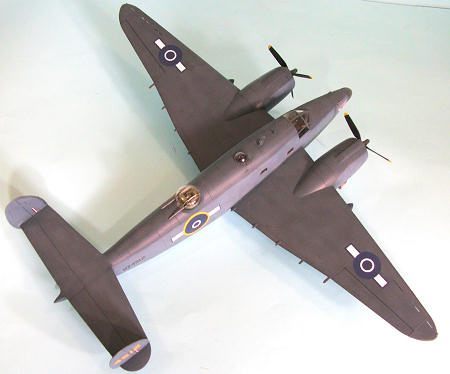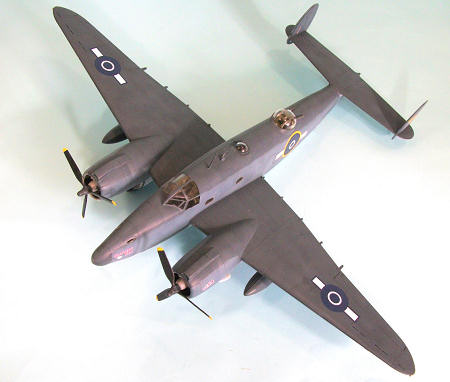Revell 1/48 PV-1 Ventura
|
KIT #: |
85-5531 |
|
PRICE: |
$36.99 SRP |
|
DECALS: |
Three options |
|
REVIEWER: |
Tom Cleaver |
|
NOTES: |
Xtradecal
48-097 “Lockheed PV-1 Ventura”
Scale Aircraft
Conversions white metal landing gear |

Developed as a follow-on design to the
Hudson
patrol bomber developed from the Lockheed Model 14 Electra, the
Ventura
was based on the Lockheed Model 18 Lodestar.
Uprated with two Pratt & Whitney R-2800s, the airplane
first appeared in 1941, produced by Lockeed-Vega in
Burbank.
Following the
US
entry into the war, the
US
Army Air Forces adopted it as the B-34 and
 B-37, and used it for anti-submarine
patrol and for
VIP
transport.
The
US
Navy obtained control of the aircraft when the USAAF gave up responsibility for
anti-submarine patrols in US coastal waters, re-designating it the PV-1.
B-37, and used it for anti-submarine
patrol and for
VIP
transport.
The
US
Navy obtained control of the aircraft when the USAAF gave up responsibility for
anti-submarine patrols in US coastal waters, re-designating it the PV-1.
The RNZAF had first come into contact when 487 Squadron
was issued
Ventura
Is in 1942, which were used in the medium-bombing role on the Channel Front.
487 was happy to give these up the following year for
re-equipment with Mosquitos.
The RAF continued to use Venturas in the general
reconnaissance and training role.
In the Pacific, the RNZAF received PV-1 Venturas
beginning in the summer of 1943, to be used as replacements for the war-weary
Hudsons.
The first RNZAF Venturas arrived at Henderson Field in
October 1943, where they were used for general reconnaissance,
photo-reconnaissance, survivor patrols, and minelaying and bombing missions
throughout the Solomons area.
One mission of note happened on Christmas Eve 1943, when
NZ4509 piloted by Flying Officer Don Ayson, was attacked by nine Zeros over
St.George's Channel while on an air-sea rescue mission, shooting down three
confirmed plus two probables, while the rest were driven off by the defense.
Ayson and navigator W.N. Williams were awarded the
DFC,
while gunner Flight Sergeant G.E Hannah was awarded the DFM for their action.
Four RNZAF Venturas and four Japanese Zeros met in
combat on
January 28, 1944,
the last aerial combat in the Solomons/Bismarcks area for the rest of the war.
The Venturas were employed as bombers by the RNZAF for
the Rabaul campaign after the withdrawal of Japanese aerial defenses in early
1944, and continued to operate in that role in conjunction with US Marine PBJ
Mitchell squadrons until the end of the war.
Following the war, most of the
Ventura
squadrons were quickly disbanded, with the aircraft replaced by Mosquitos in
1947.
All but two were sold off as scrap in 1948.
 The
Ventura
is the first all-new 1/48 aircraft kit from Revell-Monogram since the Do-217 in the late 1990s, and has
engendered a lot of comment due to its low price and high value.
The kit comes on several sprues of grey plastic and one
of clear plastic. Surface detail is scribed and a bit heavy, though nothing that
detracts from the overall look once painted. Some critics have pointed out
detail discrepancies, and the aftermarket has already come to the rescue of
those determined to triple the price of their model with “corrections” to
provide better propeller blade, more accurate cowlings and open cowl flaps.
A resin closed bomb bay is also available for those who
cannot glue four pieces of plastic together.
As Peter Mossong says in his review of the kit at the
RNZAF site, “for 95% of modelers who want a
Ventura
in their collection, what’s in the box will be just fine.”
The
Ventura
is the first all-new 1/48 aircraft kit from Revell-Monogram since the Do-217 in the late 1990s, and has
engendered a lot of comment due to its low price and high value.
The kit comes on several sprues of grey plastic and one
of clear plastic. Surface detail is scribed and a bit heavy, though nothing that
detracts from the overall look once painted. Some critics have pointed out
detail discrepancies, and the aftermarket has already come to the rescue of
those determined to triple the price of their model with “corrections” to
provide better propeller blade, more accurate cowlings and open cowl flaps.
A resin closed bomb bay is also available for those who
cannot glue four pieces of plastic together.
As Peter Mossong says in his review of the kit at the
RNZAF site, “for 95% of modelers who want a
Ventura
in their collection, what’s in the box will be just fine.”
Afermarket decals may be more popular for those who want
do have something without an octopus on it.
Xtradecals has been first out of the box with sheet
48-097, which provides markings for two different US Navy PV-1s, two different
RNZAF aircraft, and one RAAF aircraft, in addition to markings for a Ventura I
that will be useful when that version is released in the future.
Peter Mossong, who assisted with the decals, has noted
that after the design was set, information became available that “Slippery Sam”
was NZ4512, rather than NZ4511 as long thought.
Modelers for whom this is important can create the
change with decals from their collections.
Built out of the box, the Revell Ventura presents no
difficulties however one wishes to do it.
Read the instructions, follow them, and all will be
well.
While some may think the cockpit could have more detail,
what’s there is just fine once the canopy is in place, since not that much can
actually be seen.
The turret is similar, in that the detail that can be
seen inside is suf ficient for most modelers.
The kit comes with the bomb bay designed to be open, but
if one wishes to glue the doors shut it is not difficult; I found that doing
this before gluing the fuselage halves together allowed me to get the parts
fitted correctly more easily.
ficient for most modelers.
The kit comes with the bomb bay designed to be open, but
if one wishes to glue the doors shut it is not difficult; I found that doing
this before gluing the fuselage halves together allowed me to get the parts
fitted correctly more easily.
While aftermarket engines are available for those who
want them, what is provided in the kit looks just fine when fully assembled; I
have never been able to understand why anyone worries about the rear of an
engine since it cannot be seen once installed.
The one thing that really does need correction is the
propellers.
The props in the kit are based on those used by a restored
aircraft in
Canada,
and are not the correct paddle shape for the operational aircraft.
I had extra paddle props from a Revell B-17F (which uses
different props if you are doing it correctly), which only needed to be cut down
by about a sixteenth of an inch and then reshaped.
Those without such props in their parts stash can get
corrected propellers from Lone Star Models, Vector, or Squadron True Details.
 After pre-shading the model, I painted it in the
tri-color scheme using Tamiya flat White, Intermediate Blue and Field Blue (a
better color than Tamiya’s “Sea Blue” in my opinion), which were “faded” as they
would have been after exposure to tropic sunlight.
The RNZAF aircraft had their de-icer boots removed and
overpainted with Sea Blue, which is how I did this model.
After pre-shading the model, I painted it in the
tri-color scheme using Tamiya flat White, Intermediate Blue and Field Blue (a
better color than Tamiya’s “Sea Blue” in my opinion), which were “faded” as they
would have been after exposure to tropic sunlight.
The RNZAF aircraft had their de-icer boots removed and
overpainted with Sea Blue, which is how I did this model.
The Xtradecals worked great. I replaced the yellow
“4511" decal with “4512" out of the decal dungeon and also used a “2" to change
the serial number.
My only real complaint is that the fuselage roundels
appear to be too large from the photos at Peter Mossong’s site, and do not
include the white bar used on
New Zealand
insignia in the combat zone.
I didn’t have any correct smaller roundels, but did use
bars cut off US insignia decals in the dungeon.
I weathered the model with exhaust stains, then attached
the landing gear, props, and turret.
I have to admit I was surprised to find the
Ventura
the subject of an injection-molded release from a mainstream kit manufacturer.
The airplane has previously been available in 1/48 as a
vacuform from Koster Aero Enterprises and as a limited-run kit from Fonderies
Miniatures.
I’m also surprised by all the hoorah over getting aftermarket
“corrections” for a kit of what is really a ve ry “second-line” airplane.
However, if I were to provide my list of “gotta do”
aircraft for which kits do not exist, I am sure there are many who would be as
surprised by some items on that list as I am by this kit.
That said, this is a competent model, easily built, and
looks nice when done.
In this age of ever-increasing prices, it is a bargain
for what one gets, and can be easily recommended to anyone of any skill level
who finds the subject interesting.
ry “second-line” airplane.
However, if I were to provide my list of “gotta do”
aircraft for which kits do not exist, I am sure there are many who would be as
surprised by some items on that list as I am by this kit.
That said, this is a competent model, easily built, and
looks nice when done.
In this age of ever-increasing prices, it is a bargain
for what one gets, and can be easily recommended to anyone of any skill level
who finds the subject interesting.
Review kit courtesy of my wallet.
Tom
Cleaver
March 2012
Copyright ModelingMadness.com. All rights reserved. No reproduction in part or in whole without express permission. If you would like your product reviewed fairly and fairly quickly, please contact the editor or see other details in the
Note to
Contributors.
Back to the Main Page
Back to the Review
Index Page 2024


 B-37, and used it for anti-submarine
patrol and for
B-37, and used it for anti-submarine
patrol and for  The
The 

 ry “second-line” airplane.
However, if I were to provide my list of “gotta do”
aircraft for which kits do not exist, I am sure there are many who would be as
surprised by some items on that list as I am by this kit.
That said, this is a competent model, easily built, and
looks nice when done.
In this age of ever-increasing prices, it is a bargain
for what one gets, and can be easily recommended to anyone of any skill level
who finds the subject interesting.
ry “second-line” airplane.
However, if I were to provide my list of “gotta do”
aircraft for which kits do not exist, I am sure there are many who would be as
surprised by some items on that list as I am by this kit.
That said, this is a competent model, easily built, and
looks nice when done.
In this age of ever-increasing prices, it is a bargain
for what one gets, and can be easily recommended to anyone of any skill level
who finds the subject interesting.